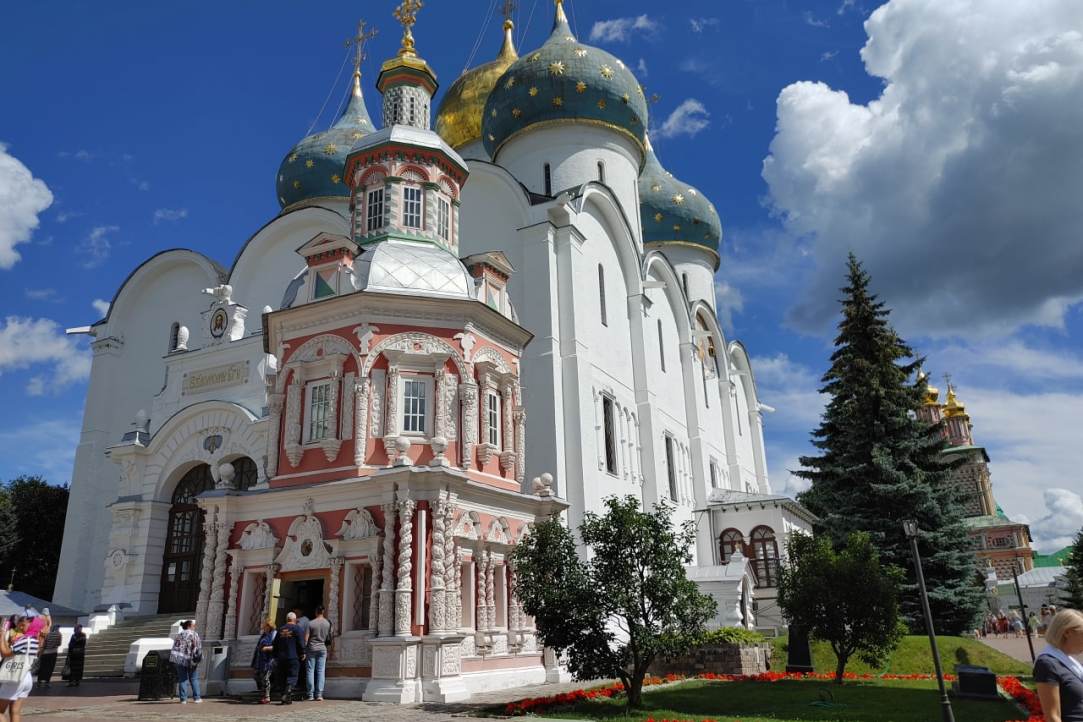Day Trip: Discover an Ancient Russian Monastery in Sergiev Posad

Whether you love the architecture of Moscow’s monasteries and churches or simply want to get away from the city, I would strongly recommend a day tour of Sergiev Posad to see the Trinity Lavra of St Sergius.
I visited the city on a cloudy day in July—the most crowded time of the year. I would choose a less-crowded time to go back again. As a year-round destination, Sergiev Posad is picturesque whether under autumn leaves or winter snow.
Located only 70 km from Moscow, Sergiev Posad is an excellent destination for a day trip to the Golden Ring, where you can enjoy the atmosphere of the picturesque countryside and be amazed by the ancient architecture and legacy of this Orthodox pearl.
Sergiev Posad—a Gem in the Golden Ring
They say that if you have only seen New York, then you haven't seen the United States. The same goes for Russia—if you have only been to Moscow, then you've only seen part of the picture. And the Golden Ring helps to fill out that picture.
The Golden Ring is a tourist route across ancient towns of northwest Russia that feature historic and cultural monuments, as well as folk crafts centres. The Golden Ring traditionally includes Sergiev Posad, Pereslavl-Zalessky, Rostov, Yaroslavl, Kostroma, Ivanovo, Suzdal, and Vladimir.
The history of Sergiev Posad dates back to the 14th century. The city is named after its founder—St Sergius of Radonezh, who remains one the most venerated saints in Russia.
Sergiev Posad is the spiritual center of the Russian Orthodox Church. The Trinity Lavra of St Sergius was one of the wealthiest and largest monasteries in the country, and it has an interesting history beneath its beauty.
In the early 20th century, the monastery was closed for a short time by the Soviet government, but was eventually handed back to the Russian Orthodox Church after the Second World War.
The city also has a great landscape with picturesque wooden homes and neoclassical buildings.
My advice is to wander around a bit before heading to the monastery. Fans of Russia’s traditional wooden houses are sure to find some colorful gems in Sergiev Posad.
Walking in the city is like going back in time. The unique and rewarding route features medieval towns and an astonishing number of churches and monasteries. Many local communities there still live a traditional rural way of life, and proudly display its past.
How to Get There
The quickest way to get to Sergiev Posad is via the express train to Aleksandrov, which takes about an hour. The train only stops in Sergiev Posad for one minute, so make sure you are ready to get off. You can also get to Sergiev Posad by standard suburban trains, which run frequently and take around 1½ hours. Both the express train and the suburban trains leave from Moscow’s Yaroslavsky railway station.
Tickets for the express train cost around 150–210 roubles and must be bought in advance.
Tickets for suburban trains cost 200–400 roubles and can be bought on the day of travel from a ticket desk or automatic ticket machine.
Landmarks
Blinnaya Hill (Блинная гора–‘Pancake Hill’)
Located between the train station and the monastery, Blinnaya Hill is hard to miss.
Once the home of the best pancakes in Sergiev Posad, it is now known for offering the best panorama view of the local sights in the city center—including St Sergius monastery and the local cathedrals and museums.
The Cathedrals
The main sight in the city is the Trinity Lavra of St Sergius. Here, in 1337, the spiritual leader Sergius built a small wooden church in the name of the Holy Trinity. Soon after his death, Sergius was canonised by the Orthodox church and honored as a saint by the Catholic Church. Every year, thousands of pilgrims visit the monastery and the Trinity Cathedral to see the relics of the saint, as well as works by the renowned icon painter Andrei Rublev.
‘The Swan’
Uspensky Cathedral contains the shrine of Russia's most controversial ruler—Boris Godunov, who made a valuable gift to the convent in order to acknowledge the importance of the Lavra. By order of the Tsar, several copper bells were cast and placed in the monastery's belfries. One of the bells had a defect that caused it to produce a remarkably pure sound, prompting people to start calling it ‘the Swan’. It was believed that the bell brings luck and can only presage good news.
‘The Swan’ is one of the few surviving bells from those ancient and mystical times.
Museums
The State History and Art Museum, located within of the monastery, contains a rich collection of old Russian paintings and various works of art dating from the 14th–17th centuries. The collection includes over 120,000 items: ancient icons, medieval manuscripts and old printed books, icon and ornamental embroideries, church utensils, articles of gold and silver, paintings, engravings, folk and contemporary art.
The Museum of Toys has a collection of more than 30,000 toys, including those from Imperial and Soviet Russia. Visitors can make various toys and paint Russian nesting dolls.
For full-time students of Russian universities, tickets to the Museum of Toys cost 120 roubles on weekdays and 150 roubles on weekends and holidays.
Souvenirs
The square outside the monastery hosts a souvenir market selling traditional Russian souvenirs (such as nesting dolls in a variety of designs and sizes) and icons—especially ones of St Sergius.
Useful Tips
There are some rules that you must follow while inside the Lavra. For example: turn off your flashlight and your ringtone in the cathedrals, and do not smoke or make noise while on the premises. Make sure to check the regulations at the entrance!
Pay careful attention when choosing your clothes beforehand: the Lavra does not allow shorts, skirts shorter than knee length, shirts with a deep neckline or uncovered shoulders. Women should remember to cover their heads as well.
On your way back to Moscow from Sergiev Posad, you can relax and enjoy the typical Russian scenery: birch forests, green hills, small villages and quiet rivers. I hope you have a memorable trip to this magnificent city in the Golden Ring!
Text by Lý Trang, second-year master’s student of Critical Media Studies, intern at the HSE University English website team

